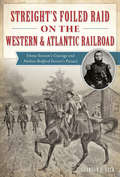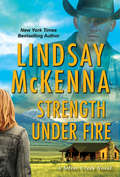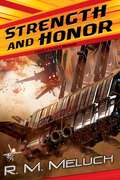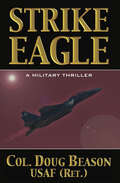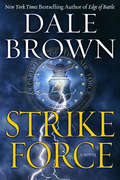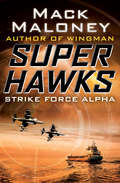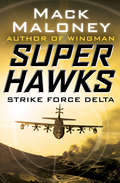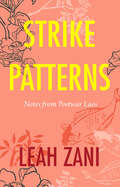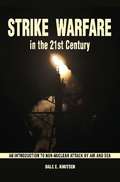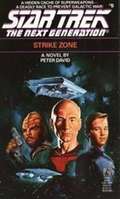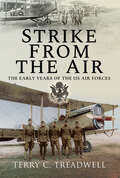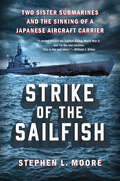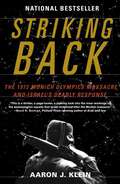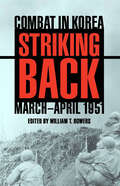- Table View
- List View
Street Without Joy: The French Debacle in Indochina (Stackpole Military History Series)
by Bernard B. FallFirst published in 1961 by Stackpole Books, Street without Joy is a classic of military history. Journalist and scholar Bernard Fall vividly captured the sights, sounds, and smells of the brutal— and politically complicated—conflict between the French and the Communist-led Vietnamese nationalists in Indochina. The French fought to the bitter end, but even with the lethal advantages of a modern military, they could not stave off the Viet Minh insurgency of hit-and-run tactics, ambushes, booby traps, and nighttime raids. The final French defeat came at Dien Bien Phu in 1954, setting the stage for American involvement and a far bloodier chapter in Vietnam&‘s history. Fall combined graphic reporting with deep scholarly knowledge of Vietnam and its colonial history in a book memorable in its descriptions of jungle fighting and insightful in its arguments. After more than a half a century in print, Street without Joy remains required reading.
Streight's Foiled Raid on the Western & Atlantic Railroad: Emma Sansom’s Courage and Nathan Bedford Forrest’s Pursuit (Civil War Series)
by Brandon H. BeckIn the spring of 1863, Union colonel Abel D. Streight sought to raid and destroy parts of the vital span of the Western and Atlantic Railroad in north Georgia with his mule-riding infantry brigade. Determined to thwart the potentially deadly attack, Confederate general Nathan Bedford Forrest fervently pursued Streight's forces. With the help of unlikely ally fifteen-year-old Emma Sansom of Gadson, Alabama, Forrest falsely convinced Streight he was vastly outnumbered, foiled the raid and forced Streight's surrender. Brandon H. Beck details Streight's dubious plan and the exciting story of a running battle between hunter and quarry that colors history from the hills of northeast Mississippi to the heart of Georgia.
Strength Under Fire (Silver Creek #3)
by Lindsay McKennaNew York Times bestselling author Lindsay McKenna returns to Silver Creek, Wyoming, where a Black Ops veteran finds the strength to fight again when a dangerous terrorist group comes after his beautiful boss . . . Bereft after the brutal loss of her parents, Dana Scott sinks nearly every dime of her inheritance into buying Wildflower Ranch, believing that once she restores the rustic cabin, and farms the untamed acreage, her soul will be whole once more. Hiring wrangler Colin Gallagher to help out just makes sense. But as she works side by side with the handsome loner, she feels an unexpected kinship, and a longing for connection she believed was lost to her forever . . . Colin is only in Silver Creek long enough to make some money and move on. Restless, spiritually broken, the former Army Ranger has nothing left to give after his harrowing time in battle. But helping Dana make a life for herself has him yearning for more. Until the domestic terrorists that destroyed Dana&’s family catch up with her, determined to silence her forever. It&’s a threat that has Colin calling on all his considerable training to keep safe the woman who has taken hold of his heart . . . &“The romance is . . . rich with emotion and intensified by suspense.&”—Publishers Weekly starred review on Silver Creek Fire
Strength and Conditioning for the Human Weapon System
by Christopher Myers Cj FrenchA central focus of the US Military is the Human Weapon System (HWS) and the optimization of this weapon system. Over the past decade, the Department of Defence has invested in programs termed Human Performance Optimization (HPO) programs. Human performance for the human weapon system is much different than the civilian athlete. Therefore, the human weapon system's rehabilitation and performance training requirements are different and must be considered. This book demonstrates the following to strength coaches and practitioners: Why to view the HWS as a multi-faceted system that requires a more inclusive program than needed by athletes. Provide updated methodology to create a strength and conditioning program specifically for the HWS populations. Introduce and define advanced strength and conditioning methodologies SC professionals use within the US Military and law enforcement performance programs.
Strength and Honor (Tour of the Merrimack #4)
by R. M. Meluch"Earth's space forces, spearheaded by the United States, had long been at war with the forces of the Palatine Empire, a neo-Roman culture that broke away from Earth's control long ago. But when the alien life-form known as the Hive - a biological force whose only imperative was seek and devour - began wreaking destruction across the galaxy, the Romans were forced to turn to Earth for help. Ceasar Magnus surrendered to Captain John Farragut - commander of the pride of the U.S. space fleet, the battle class starship, the U.S.S. Merrimack - and the period known as the Subjugation began." "Even since the surrender, an uneasy peace and alliance had been in force, as all humanity and their alien allies joined together to battle the Hive." "When the threat of the Hive seemed to have been neutralized, John Farragut was summoned to Ceasar Magnus' fortress to be honored. But instead, Ceasar Magnus was assassinated and Farragut and the Merrimack were lucky to escape from what could have proved a deadly trap." "Now Magnus' son Romulus has taken control of the Palatine Empire and has himself proclaimed Ceasar, and Captain Farragut and the Merrimack are about to face their greatest challenge ever." "The forced alliance between the interplanetary Empire of Rome and the United States-led Earth is shattered as Ceasar Romulus declares war, striking at the U.S. Deep Space base and then following up with a direct attack against Earth. Merrimack has no choice but to retaliate with an assault on the Roman capital world of Palatine. In the midst of this chaos, the Hive renews its invasion. And even if John Farragut and his crew can survive all of this, the rogue Roman palterner Augustus - who was long been assigned to his own mission aboard Merrimack - flees the ship when war is declared, and no one knows whether he is only biding his time, waiting to meet Farragut in a final deadly showdown."--BOOK JACKET.
Strengthening Data Science Methods for Department of Defense Personnel and Readiness Missions
by Engineering Medicine National Academies of SciencesThe Office of the Under Secretary of Defense (Personnel & Readiness), referred to throughout this report as P&R, is responsible for the total force management of all Department of Defense (DoD) components including the recruitment, readiness, and retention of personnel. Its work and policies are supported by a number of organizations both within DoD, including the Defense Manpower Data Center (DMDC), and externally, including the federally funded research and development centers (FFRDCs) that work for DoD. P&R must be able to answer questions for the Secretary of Defense such as how to recruit people with an aptitude for and interest in various specialties and along particular career tracks and how to assess on an ongoing basis service members’ career satisfaction and their ability to meet new challenges. P&R must also address larger-scale questions, such as how the current realignment of forces to the Asia-Pacific area and other regions will affect recruitment, readiness, and retention. While DoD makes use of large-scale data and mathematical analysis in intelligence, surveillance, reconnaissance, and elsewhere—exploiting techniques such as complex network analysis, machine learning, streaming social media analysis, and anomaly detection—these skills and capabilities have not been applied as well to the personnel and readiness enterprise. Strengthening Data Science Methods for Department of Defense Personnel and Readiness Missions offers and roadmap and implementation plan for the integration of data analysis in support of decisions within the purview of P&R.
Stresemann and the Rearmament of Germany
by Hans W. GatzkeThe first major study of Stresemann following declassification of his papers in the previous year. Written by Hans W. Gatzke, then a Professor at John Hopkins, who was intrigued by the enigmatic Gustav Stresemann (1878-1929), a German politician and statesman who served briefly as Chancellor in 1923 and Foreign Minister 1923-1929, during the Weimar Republic. He was co-laureate of the Nobel Peace Prize in 1926. His most notable achievement was the reconciliation between Germany and France, for which he and Aristide Briand received the Nobel Peace Prize. During a period of political instability and fragile, short-lived governments, he was generally seen as the most influential cabinet member in most of the Weimar Republic’s existence. During his political career, he represented three successive liberal parties; he was the dominant figure of the German People’s Party during the Weimar Republic.The study is based on the unpublished papers of Dr. Gustav Stresemann, which came into Allied possession at the end of World War II as part of the vast collection of German Foreign Ministry documents. They were opened to research in the spring of 1953, as the result of a U.S.-British agreement.“A valuable contribution, enhanced by Mr. Gatzke’s penetrating insights and sureness of style.”—Fritz Stern, Columbia University
Stretcher-bearers
by Mark JohnstonStretcher-bearers is a compelling account of the experience of Australian stretcher-bearers during the First and Second World Wars. Respected military historian, Mark Johnston traces the development of formal stretcher-bearing from its origin in the early nineteenth century under Napoleon to the Second World War. Johnston draws on accounts by stretcher-bearers who worked on the front line, as well as tributes from rescued soldiers, to deepen our understanding of the crucial role these soldiers played in Gallipoli, Palestine, the Western Front in World War I, and in the Middle East and the Pacific in World War II. The narrative is further driven by rich imagery, featuring over 130 full-page photographs. This book provides a generously illustrated, engaging and moving account of the history of the stretcher-bearer, a figure praised by countless Diggers but never previously the subject of a book.
Stretching and Exploiting Thresholds for High-Order War: How Russia, China, and Iran Are Eroding American Influence Using Time-Tested Measures Short of War
by Ben Connable Jason H. Campbell Dan MaddenSince 9/11, Russia, China, and Iran have successfully exploited or stretched U.S. thresholds for high-order war in order to further their strategic ends and, in the process, undermine U.S. interests. Each of these countries has made expert use of some combination of measures short of war to enact its strategies. This report describes those measures and how these nation-states use them and explains why U.S. notions of thresholds might be outdated.
Strike Command
by John ParkerThe two key components of air warfare conducted by the Royal Air Force virtually for the whole of the last century were the fighters and the bombers. By the 1960s these two roles had evolved into a single force known in the RAF by its current title, Strike Command. Colloquially, their pilots were known as Top Guns. Full of personal tales of airborne derring-do in just about every conflict in which Britain has been engaged, this is the latest in John Parker's excellent series of elite fighting units.
Strike Command
by John ParkerThe two key components of air warfare conducted by the Royal Air Force virtually for the whole of the last century were the fighters and the bombers. By the 1960s these two roles had evolved into a single force known in the RAF by its current title, Strike Command. Colloquially, their pilots were known as Top Guns. Full of personal tales of airborne derring-do in just about every conflict in which Britain has been engaged, this is the latest in John Parker's excellent series of elite fighting units.
Strike Eagle: A Military Thriller
by Doug BeasonThe search is on for the Vice President after Air Force Two disappears in this action-packed military thriller by the author of Ill Wind. When last contacted, Air Force Two, with the Vice President of the United States aboard, was flying high over the Philippine jungle. On board was not only the Vice-President, but the &“football&” that gave him the power to initiate nuclear war. For in Washington, D.C., the U.S. President lay dying. At the newly reconstituted Clark Air Base, the orders went out: Air Force Two, aloft or downed, had to be found. The Vice President, alive or dead, had to be brought back. The hunt was on. The race against time and the ultimate terror had begun . . .
Strike Force (Able Team #35)
by Dick Stivers Ron RenauldIt's a boyhood dream come true when Gadgets Schwarz takes part in a baseball camp featuring some of the game's best players. But the thrill is short-lived when he discovers that Doug Bendix, his baseball idol, is somehow involved in organized crime. Schwarz believes Bendix is being strong-armed by the mob. But when his colleagues join him, Able Team uncovers a drug operation that threatens to ignite an ethnic gang war. The temperature in Florida is ice-cold compared to the heat generated by Able Team when they drive this mission over the wall. But this game doesn't have extra innings-it's into sudden death overtime! Carl Lyons, Pol Blancanales and Gadgets Schwarz, three roaring avengers whose covert action squad is the fiercest in the world. Your life is in their hands!
Strike Force (Patrick McLanahan #13)
by Dale BrownThe Battle For Control Of Iran... Begins In Space<P> When a disgraced former Iranian military chief of staff engineers an insurgency that threatens to destroy the theocratic regime in Iran, a new era appears to be dawning in the Middle East. But one must be wary of old enemies...<P> On the run from the Pasdaran, the theocrat's terror army, and unable to count on support from his friends in the regular army, Iranian rebel leader General Hesarak al-Kan Buzhazi desperately turns to his old nemesis, U.S. Air Force Lieutenant-General Patrick McLanahan, for help. Unwilling to commit American forces in an Iranian civil war, and with time running out, the U.S. president authorizes McLanahan to utilize a new, top-secret fleet of globe-crossing spaceplanes, the XR-A9 Black Stallions, led by test pilot and astronaut Captain Hunter Noble. Within hours, McLanahan's Air Battle Force turns the tide, possibly changing the course of history in the Middle East for generations.The advent of almost instantaneous global reach, along with the reactivation of America's first military space station, Silver Tower, has rekindled fears of a space arms race, and the growing insurgency in Iran is threatening to erupt into a worldwide jihad. But McLanahan finds himself embroiled in even more bitter battles at the White House, between those who support his space-based military initiative and those who are working secretly to undermine it. When McLanahan is forced to concentrate on his political and personal battles back at home, it's left to Hunter Noble and his team of young American space engineers to keep the fires of freedom in the Middle East from exploding completely out of control. Filled with the latest cutting-edge weaponry, geopolitical intrigue, high-flying suspense, and a colorful cast of characters, Strike Force is New York Times bestselling master Dale Brown at his best.
Strike Force Alpha: Strike Force Alpha, Strike Force Bravo, Strike Force Charlie, And Strike Force Delta (Superhawks #1)
by Mack MaloneyFrom the bestselling author of the Wingman series comes the first book in an action-packed series featuring the Superhawks, an ultrasecret team of patriotic US military specialists who declare war against every terrorist connected to the attacks of 9/11 Their mission was to kill bin Laden. They wound up saving the world. Assembled by mysterious superspy Bobby Murphy, trained by the best and ignoring the generals and the politicians, the Superhawks become America's ruthless answer to the post-9/11 reality. Hidden aboard the Ocean Voyager, a floating airbase disguised as a rusty containership, this ultraelite unit of assault troops carries out brazen, daring raids all over the Persian Gulf as it seeks its number-one target: al-Qaeda's master mission planner. When chatter comes in about the Next Big Thing, it's up to the Superhawks to strike out with all their fury to stop the deadliest terrorists in history from taking out the free world.
Strike Force Bravo: Strike Force Alpha, Strike Force Bravo, Strike Force Charlie, And Strike Force Delta (Superhawks #2)
by Mack MaloneyThe counterterrorism battle shifts to Southeast Asia in the second explosive Superhawks thriller from Mack Maloney, bestselling author of the Wingman series A terrorist cell with direct links to al-Qaeda's leader captures Singapore's Tonka Tower Hotel, one of the world's tallest skyscrapers. The terrorists contact dozens of news organizations so the world can witness its destruction. News copters surround the building just as the Superhawks enter--rappelling from military choppers, guns blazing, disarming the terrorists' bombs seconds before they detonate. It would seem that kudos are due, but the Superhawks are supposed to be top secret. The Pentagon bigwigs are steamed and send in a team of Navy SEALs to wrangle with the Superhawks. But al-Qaeda is hatching a new plot involving Stinger missiles. Can the Superhawks stop it in time? Or will the sprawling American military bureaucracy trip itself up before they even have a chance to try?
Strike Force Charlie: Strike Force Alpha, Strike Force Bravo, Strike Force Charlie, And Strike Force Delta (Superhawks #3)
by Mack MaloneyBurned by their government, the Superhawks must take down traitors and terrorists when the global war on terror returns to America in the third book in this action-packed series by bestselling author Mack Maloney Preparing to unleash a series of attacks from the heart of America, dozens of al-Qaeda terrorists sneak into the United States under paper-thin disguises--refugees, shipwreck survivors, a team of soccer players--overcoming tight border security with help from treasonous US officials. One potential obstacle--the Superhawks--gets eliminated when the US government burns the entire team. After narrowly escaping imprisonment or worse, the Superhawks are left to die out in the cold. But rather than rolling into their graves, the men of the Ocean Voyager become ghosts. Vengeful ghosts. Alongside the mysterious Bobby Murphy, the Superhawks team up with a group of American citizens to protect the country, save thousands of innocent lives, and purge the government of high-level traitors who threaten the very freedoms we hold most dear.
Strike Force Delta: Strike Force Alpha, Strike Force Bravo, Strike Force Charlie, And Strike Force Delta (Superhawks #4)
by Mack MaloneyTrained by the best, forged in the crucible of combat, the world's deadliest counterterrorism team returns for an ultimate showdown with al-Qaeda in the fourth novel of bestselling author Mack Maloney's super-charged Superhawks series Their mission was to kill bin Laden. They wound up saving the world. Stocked with new helicopters and weapons, master spy Bobby Murphy's floating air base, Ocean Voyager, sails for one final journey. But in West Africa, a supersquad from America's premier special ops unit, Delta Force, comes under attack. Though they take out over fifty terrorists, the secret Delta Thunder team is captured. It's up to the Superhawks to invade the terrorist fortress, save the Delta Thunder guys, and flatline the "crown prince" of terrorism before he can execute the Delta team on live television.
Strike Patterns: Notes from Postwar Laos
by Leah ZaniA strike pattern is a signature of violence carved into the land—bomb craters or fragments of explosives left behind, forgotten. In Strike Patterns, poet and anthropologist Leah Zani journeys to a Lao river community where people live alongside such relics of a secret war. With sensitive and arresting prose, Zani reveals the layered realities that settle atop one another in Laos—from its French colonial history to today's authoritarian state—all blown open by the war. This excavation of postwar life's balance between the mundane, the terrifying, and the extraordinary propels Zani to confront her own explosive past. From 1964 to 1973, the United States carried out a covert air war against Laos. Frequently overshadowed by the war with Vietnam, the Secret War was the longest and most intense air war in history. As Zani uncovers this hidden legacy, she finds herself immersed in the lives of her hosts: Chantha, a daughter of war refugees who grapples with her place in a future Laos of imagined prosperity; Channarong, a bomb technician whose Thai origins allow him to stand apart from the battlefields he clears; and Bounmi, a young man who has inherited his bomb expertise from his father but now struggles to imagine a similar future for his unborn son. Wandering through their lives are the restless ghosts of kin and strangers. Today, much of Laos remains contaminated with dangerous leftover explosives. Despite its obscurity, the Secret War has become a shadow model for modern counterinsurgency. Investigating these shadows of war, Zani spends time with silk weavers and rice farmers, bomb clearance crews and black market war scrap traders, ritual healers and survivors of explosions. Combining her fieldnotes with poetry, fiction, and memoir she reflects on the power of building new lives in the ruins.
Strike Warfare
by Dale E. KnutsenStrike warfare is a term that is rarely used in the popular media even though reports of conflicts often describe its application or effects. Those brief snippets of information seldom provide a complete picture of what is happening at the time, and they almost never explain the operational or technical background that influences how such actions occur. This leaves the average reader or viewer with an information void, a gap in understanding.This book is intended to fill that gap. It does so in a logical and methodical fashion, building the picture piece by piece using easily understandable language. It begins with a discussion of the more newsworthy side of the subject, strike warfare operations. All of the key elements are addressed: targets, defenses, resources, and the several steps required to prosecute an attack. The book's goal is to eliminate the uncertainty, the mystery and the outright fiction that sometimes exists in popular versions of the story. The second half of the book deals with an even less understood part of the subject, the development of strike weapons. The average citizen may occasionally hear of cost overruns, development test failures or some other negative aspect of military development programs, but there is hardly any background information available to the American taxpayer on how such programs function in general. Again, the book aims to correct a deficiency with respect to an accurate account of how strike weapons are actually developed. The entire development and life cycle is described, step by step, at the summary level. The author then closes with some thoughts about lessons learned and trends for the future. This is recommended reading for anyone with an interest in or a connection with strike warfare or strike weapons development. It should prove helpful to military or civilian newcomers to the field, members of the news media, and legislators or members of their staff dealing with military matters. But first and foremost, it was written to provide the average American taxpayer a better understanding of an important and powerful military capability.
Strike Zone (Star Trek: The Next Generation #5)
by Peter DavidDeep in the uncharted regions of our galaxy, the Kreel, a primitive, warlike race have stumbled upon weapons powerful beyond their wildest imagination. The Kreel have used those weapons to attack their most bitter enemies, the Klingons. Captain Jean-Luc Picard and the crew of the U.S.S. EnterpriseTM are called in to mediate the dispute by ferrying diplomatic teams from the two warring races to the source of their conflict, the mysterious planet where the weapons were discovered in an attempt to find a peaceful solution to the conflict, and discover the origins of the super-powerful weapons. Before the entire galaxy errupts into a full-scale war...
Strike from the Air: The Early Years of the US Air Forces
by Terry C. Treadwell“Follows the development of US aviation from the captive balloons of the Civil War, through WWI and into the post war years . . . Highly Recommended.” —FiretrenchStrike from the Air looks at the early development of the U.S. military aviation branches, starting with the Civil War and moving to the first use of military aircraft during General Pershing’s pursuit of the revolutionary Pancho Villa. Before the country was drawn into the First World War, a number of Americans traveled to Europe to volunteer for the Lafayette Escadrille in France, as well as the Royal Flying Corps and the Royal Naval Air Service. Many of these men eventually joined the newly created United States Air Service, taking their valuable experience and knowledge with them. Among the notable early US aviators were individuals such as Eugene Bullard, the first African-American military pilot, and eccentric loners like Frank Luke. The part played by the US Navy and USMC is not neglected.At the end of the First World War, a group of American pilots joined together to form the Kosciuszko Squadron that fought against the Russians in the Polish/Russian War. The final part of the book contains escape reports by USAS pilots and observers, which gives a real insight into the conditions they were subjected to in German prison camps during the First World War. To complete this fascinating look at those exciting and challenging early days, Strike from the Air includes approximately 250 photographs, many of which have ever been seen before.“A remarkable book that shows just how difficult a start American military aviation endured.” —New York Journal of Books
Strike of the Sailfish: Two Sister Submarines and the Sinking of a Japanese Aircraft Carrier
by Stephen L. MooreA gripping true-life thriller about the first US submarine to sink a Japanese aircraft carrier—and the sub&’s tragic twist of fateIn 1939 off the New England coast, the submarine USS Squalus accidentally sinks to the bottom of the sea during a training exercise, killing half her crew. Coming to the rescue is the USS Sculpin, in many ways the Squalus&’s twin. As their oxygen supply dwindles, the remaining crew aboard the Squalus are saved in a time-consuming, white-knuckle operation. Eventually the sunken submarine is raised, repaired, and returned to duty, with a new name: the Sailfish.Four years later, on patrol during the darkest days of the Pacific War, the Sailfish&’s radarman picks up the tell-tale signs of a Japanese convoy, known by U.S. intelligence to include aircraft carriers, the most formidable of all enemy ships. Never before has an American submarine taken down a carrier—much less in the middle of a typhoon. Immediately, the crewmen swing into action, embarking on a deadly game of cat-and-mouse as this once-dead boat evades enemy cruisers to stalk closer and closer to their prized target. Little do they know that aboard the Japanese carrier are survivors of an attack on the USS Sculpin, the very boat that saved the Squalis-turned-Sailfish back in &’39.Author Stephen L. Moore takes readers inside the nine-hour duel, narrating the action aboard both the Sailfish and the doomed carrier, where the American POWs fight against all odds to save their own lives before the ship goes down. Employing a wealth of new information, including long-lost survivors' accounts, fresh interviews with the last of the sub's crew, and official patrol reports, Strike of the Sailfish is the thrilling story of this strange chapter of naval history.
Striking Back
by Aaron J. KleinThe first full account, based on access to key players who have never before spoken, of the Munich Massacre and the Israeli response–a lethal, top secret, thirty-year-long antiterrorism campaign to track down the killers. 1972. The Munich Olympics. Palestinian members of the Black September group murder eleven Israeli athletes. Nine hundred million people watch the crisis unfold on television, witnessing a tragedy that inaugurates the modern age of terror and remains a scar on the collective conscien...
Striking Back: March–April 1951 (Combat in Korea #Bacs)
by William T. BowersThe editor of The Line “gives a human perspective to the war” by focusing on fighting by battalion, company, platoon, squad, and individual soldiers (The Journal of America’s Military Past).Striking Back: Combat in Korea, March–April 1951 is the second book in a three-volume series about the Korean War, examining the fighting that occurred during the late winter and early spring of the war’s first year. By the beginning of March, UN forces shifted strategic focus from defense to offense. In April, the combination of stabilized fronts and the enemy’s failed attacks made conditions ideal for launching combat offensives. The brutal nature and strategic significance of these campaigns is described in the book, which includes analysis of their profound influence on the remainder of the war. William T. Bowers provides detailed battle narratives based on eyewitness accounts recorded by Army historians within days of the operations. Through his use of personal accounts, official records, war diaries, and combat reports, Bowers sheds new light on the conflict in Korea, making this volume a must-read for military historians.“This book is unique.” —In Review

